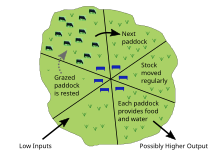User:Erg223/Climate resilience
Agriculture
[edit]Agriculture is the practice of farming responsible for the cultivation of nearly all the food consumed by humans in the modern era. As environmental disturbances increase in frequency is it important for societies to develop resilience in crops and livestock. Local and national initiatives around the world now prioritize climate-resistant agriculture as crises continue to put food distribution at risk.
Nations around the world are concerned with the possibilities of climate change reducing agricultural production. In recent years, multiple countries have experienced agricultural disruptions. For example, Honduras has suffered from cyclical water instability for years. The country reported a national drought in 2019, claiming it has lasted for 5 years prior. Throughout the group, sudden flooding was also common. Similar weather patterns throughout Central America has resulted in yields of important crops being expected to fall by up to 29% over the coming decades.[1]

Overall, climate change is expected to reduce agricultural income by 15-25%. In many countries, such as India and the United States, governments are shifting Sustainable Development Goals to the forefront of their priorities. This shift involves developing climate-resilient agricultural approaches that emphasize sustainability and productivity. The Indian Government's Ministry of Agriculture, alongside the Farmers Welfare and Indian Council of Agricultural Research, has taken several policies towards this. The main focus of their climate-resilient approach is adapting current agricultural technologies, managing resources, improving crop monitoring, and building soil and environmental health. Resulting policies include the cultivation of tolerant plant breeds and the management of water, soil nutrients, and manure. Such policies created promising returns. Tolerant breeds produced 20-25% higher yields than indigenous strains when planted in the rural districts of Maharashtra[2]. Soil management measures will also contribute to stronger growth in Indian crops.
Multiple returns of climate-resilient agriculture will be delayed. One of India's strategies, responsive crop monitoring, cannot be planned. While the government is working to create systems to guide farmers in specific situations, response farming depends on the direction of climate change. Additionally, investing in tolerant livestock breeds will decrease production in the short term. Tolerant livestock's appeal lies in their ability to resist changes to the environment as climate change worsens.[2] These immediate uncertainties are part of India's goal of promoting environmental health to support agricultural production long term.
Similar initiatives are implemented on local scales around the world. In the United States, the state of New York's department of agriculture started its Climate Resilient Farming program. This program aims to reduce the impact of climate change on agriculture and mitigate agriculture's impact on climate change. It promotes similar ideas to India's, including water management and the promotion of soil health. The climate-resilient programming also provides funds to help farmers reduce methane and properly store agricultural waste. New York state's focus on reducing greenhouse gas emissions balances developing climate-resilient agriculture and the slowing of climate change.[3]

Government support of this intersection is used to support change amongst individual farmers. As climate variability increases, the costs associated with promoting climate resilience become larger in comparison. The risk of investing in tolerant breeds, soil management, and proper environmental care can also be daunting to small farm. Such individuals have reported hesitation to implement suggested practices like reducing herd size to promote soil-healthy grazing. The popularity of climate resilient farming amongst subsistence farmers helps ease the transition to a climate-resilient system. Alongside developing new techniques, farmers can use techniques they already knew, such as no-till farming and cover cropping.[4] Government incentives remain important for helping farmers assume more risk in the uncertain business of agriculture.

Aquaculture
[edit]The process of cultivating food in aquatic as well as terrestrial ecosystems is gaining popularity. Aquaculture, or the practice of cultivating seafood, is viewed as naturally more resilient than terrestrial agriculture. Fish stock need less resources, from feed to water, than terrestrial livestock. Aquaculture may also slow the effects of climate change in the ocean. As more carbon dioxide is released into the atmosphere, more dissolves into the ocean, increasing water acidity. Farming of aquatic vegetation, such as seaweed, will remove carbon from water.[5]
| This is the sandbox page where you will draft your initial Wikipedia contribution.
If you're starting a new article, you can develop it here until it's ready to go live. If you're working on improvements to an existing article, copy only one section at a time of the article to this sandbox to work on, and be sure to use an edit summary linking to the article you copied from. Do not copy over the entire article. You can find additional instructions here. Remember to save your work regularly using the "Publish page" button. (It just means 'save'; it will still be in the sandbox.) You can add bold formatting to your additions to differentiate them from existing content. |
- ^ Masters, Jeff. "Fifth Straight Year of Central American Drought Helping Drive Migration". Scientific American Blog Network. Retrieved 2021-12-12.
- ^ a b Srinivasarao, Ch (4 February 2021). "Climate resilient agriculture systems: The way ahead". Down to Earth. Retrieved 11 December 2021.
{{cite web}}: CS1 maint: url-status (link) - ^ "Climate Resilient Farming". Agriculture and Markets. Retrieved 2021-12-12.
- ^ Lengnick, Laura (2018). "Cultivating Climate Resilience on Farms and Ranches". Sustainable Agriculture Research and Education. Retrieved 11 December 2021.
{{cite web}}: CS1 maint: url-status (link) - ^ "Climate Resilience and Aquaculture". NOAA Fisheries. 6 January 2021. Retrieved 11 December 2021.
{{cite web}}: CS1 maint: url-status (link)
